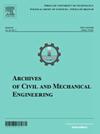Investigating the performance of basalt FRP-reinforced concrete columns: experimental and analytical insights
Abstract
Aggressive environments can lead to deficiencies or failure in reinforced concrete (RC) members because of the corrosion of reinforcing steel bars. Therefore, bars manufactured from fiber-reinforced polymer (FRP) composites have been employed as a possible substitute for steel bars in RC members. FRP bars have corrosion resistance greater than the conventional steel rebars and a higher ultimate tensile strength. The aim of current investigation was to examine the flexural and compression behavior of slender RC columns having Basalt FRP (BFRP) rebars. Six square slender columns of 240 mm size and 2.8 m long were fabricated in three sets with each set of 2 columns. The columns of the first set were reinforced with 6ϕ12 mm steel rebars (1.1%), whereas the columns of the second and third sets had internal BFRP rebars. The second and third sets differed in the diameter of BFRP rebars, and the percentage of reinforcement was nearly same. The second and third sets had longitudinal BFRP rebars of 6ϕ12 mm (1.1%) and 12ϕ8 mm (1.0%), respectively. Test specimens were subjected to concentric and eccentric (eccentricity = 50 mm) compression. The average compressive strain in BFRP rebars at maximum load was slightly greater than the crushing strain of concrete for both BFRP bar diameters (ϕ8 mm and ϕ12 mm) indicating that the compressive stress in BFRP bars can be calculated from strain compatibility. Analytical model was also carried out for developing the P–M interaction graphs for columns having BFRP rebars. The developed model included the compression resistance of BFRP rebars. The analytically predicted interaction diagrams were conservative and near the experimental ones. The test results of this study were compared with other similar studies from the literature, and the effects of eccentricity-to-depth and slenderness ratios on the second-to-first-order moment ratios were examined for eccentrically loaded FRP-reinforced concrete columns.



 求助内容:
求助内容: 应助结果提醒方式:
应助结果提醒方式:


